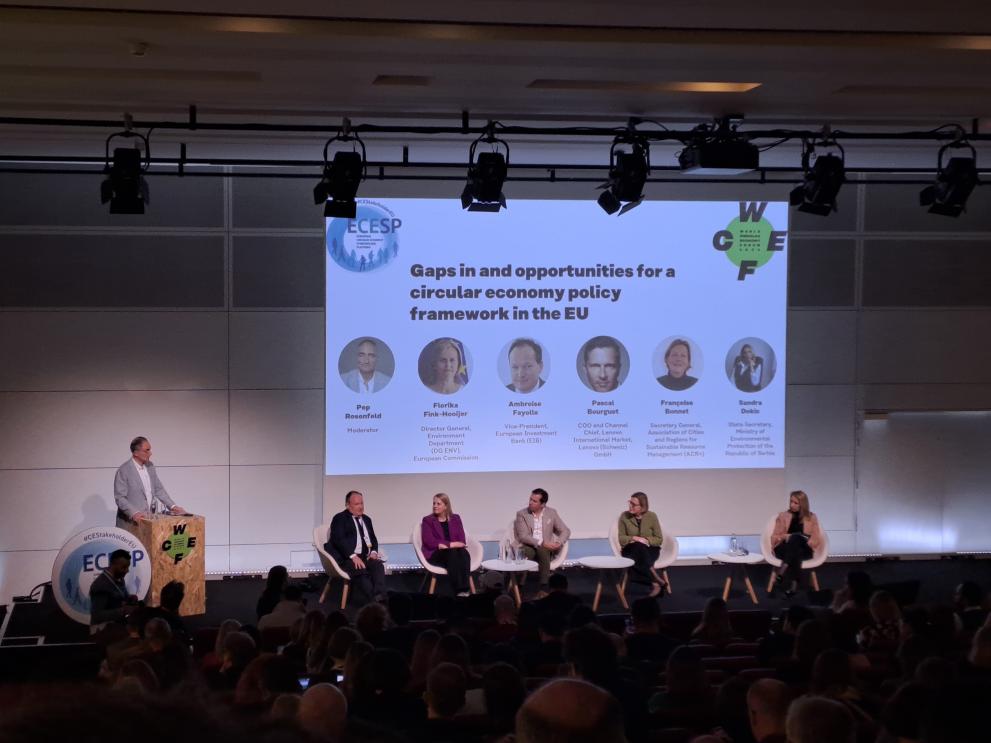
Europe generates almost 26 million tonnes of plastic waste every year. The need for a circular economy to help tackle climate change means we must reduce our consumption of new materials and reuse our waste. This requires system changes within global markets, manufacturing and industrial processes, and behaviours and mindsets. The most impactful circular solutions were centre stage last month at the World Circular Economy Forum (WCEF) 2024. Over 1 500 attendees and 8 000 virtual participants attended the conference, with 158 countries showcasing their circular economies, successes, and challenges. Representing LIFE projects from Latvia, the Netherlands, Belgium, and Italy were LIFE-IP Cmartlife, LIFE Waste to Resources IP, and LIFE PlasPLUS.
Project representatives shared a stand alongside other programmes and initiatives, such as the Innovation Council and Horizon Europe, providing an opportunity to meet different stakeholders, municipalities, ministries, and colleagues from different European institutions. The booth was visited by potential applicants for proposals and topics, as well as former beneficiaries of LIFE funding.
Representing Belgium’s efforts to accelerate and reinforce plastic recycling, specifically the region of Flanders, representatives of LIFE-IP Cmartlife showcased material from the project’s toolkit, KWITTEN – a campaign to help local municipalities switch to reusable catering crockery and cutlery for events – and hosted an accelerator session. The session, held on day 3 of the conference at the Belgian Circular Economy Forum, put the theory of the higher R strategies (refuse, reduce, reuse, repair, recycle) into practice.
In collaboration with Circular Flanders Working Agenda chemistry and plastics, they also moderated a session showcasing Flemish examples of plastic reuse. Key points included the strategic importance of getting retail giants on board to use more sustainable packaging and increase plastic reuse; reducing logistics challenges; the need for a robust legal framework; and sharing technical information and training about recycling opportunities. Returnable six-packs, launched by DW Reusables and Carrefour Belgium, were showcased as an efficient design.
Speaking about this showcase, “This session not only underscored Flanders' transition from experimental to established circular practices but highlighted the essential collaborative effort with civil society and specific sectors to forge pathways towards a sustainable and circular future,” said Els Herremans from LIFE-IP Cmartlife.
LIFE PlasPLUS showcased the economic recovery of thermoplastics, found in our cars and electrical and electronic equipment. Results of this recovery process have now been implemented at market level, in particular how the project is closing the loop in the automotive sector for a number of thermoplastics. Adding thoughts on the conference, “It was the opportunity to meet visitors, answer questions and exchange about the importance of the carbon footprint indicators in new circular value chains,” said Pierre Fiasse, LIFE PlasPLUS representative at WCEF 2024.
Showcasing efforts in Latvia, LIFE Waste to Resources IP, explored collaboration opportunities across waste management, resource efficiency, and sustainable development. They also discussed how results and pilot projects could be shared by hosting visits to Latvia to see the project in person. Commenting on the potential of these events, “Such events would be significant in promoting the dissemination of best practices, the adoption of innovations, and collaboration among various EU stakeholders,” said Alise Vecozola, Head of the Implementation Division of the project.
During WCEF 2024, a number of announcements were made, including plans for the EU Circular Economy Resource Centre which aims to drive global circularity and facilitate peer-to-peer exchanges and partnerships between the EU and third-country stakeholders. Speaking about the centre at WCEF 2024, “It is possible to make circularity the next megatrend. The vision behind the Circular Economy Resource Centre is to share policy and business know-how and best practices with partner countries,” said Jutta Urpilainen, European Commissioner for International Partnerships.
Event organiser Sitra, Finnish Innovation Fund, also published a list of Europe’s leading Circular solutions for nature which had been assessed according to their circular business models, economic viability, track records, and potential for protecting nature.
The next edition of WCEF will be held in São Paulo, Brazil, in May 2025.
The three LIFE projects align to a number of EU polices including: Waste Framework Directive, European Strategy for Plastics in a Circular Economy; Circular Economy Action Plan 2020; Packaging and Packaging Waste Directive; Landfill Waste Directive, and the Waste from Electrical and Electronic Equipment (WEEE) legislation.
Details
- Publication date
- 16 May 2024
- Author
- European Climate, Infrastructure and Environment Executive Agency

